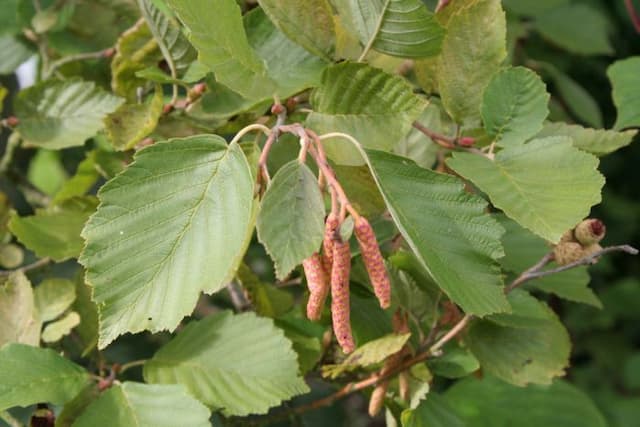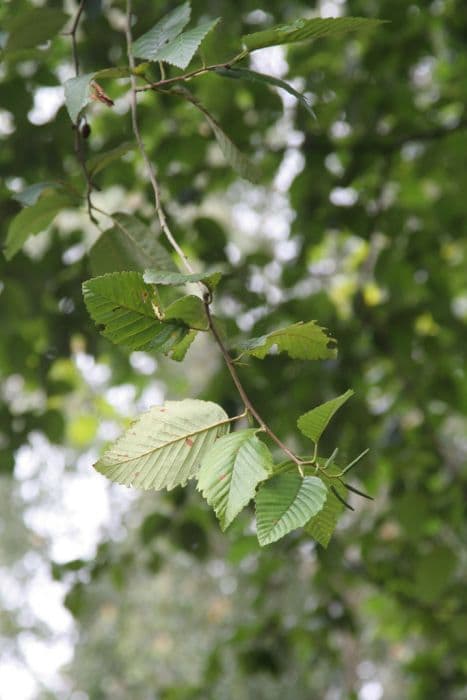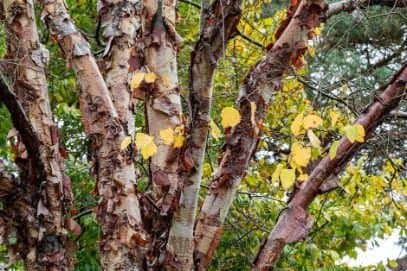Sweet Birch Betula lenta

ABOUT
The plant known as sweet birch is characterized by its dark, shiny, reddish-brown bark when it is young, which gradually becomes darker and begins to peel and flake as the plant matures. This appearance often gives it a rugged texture. Its leaves are oval to oblong in shape, with toothed edges and a pointy tip, generally having a lustrous, dark green color on top and a lighter shade underneath. During the fall, the foliage transforms into striking shades of yellow, making it a visually appealing feature in the landscape. The sweet birch also boasts cylindrical flowers called catkins, which dangle delicately from the branches. The male catkins are longer and more noticeable than the female ones. Additionally, the plant produces small fruit that is arranged on a conelike structure, which, when mature, disintegrates to release the seeds. The overall visual impression of sweet birch is one of an elegant and sturdy plant, adorned with both attractive bark and foliage that provide year-round interest.
About this plant
 Names
NamesFamily
Betulaceae.
Synonyms
Sweet Birch, Black Birch, Cherry Birch, Mahogany Birch, Spice Birch, Mountain Mahogany.
Common names
Betula carpinifolia, Betula lenta var. macrolepis, Betula lutea, Betula lenta var. uber, Betula lutea var. uber, Betula uber
 Toxicity
ToxicityTo humans
Betula lenta, commonly known as Black Birch, is not considered highly toxic to humans. This plant has been used historically for various purposes, including the flavoring of foods with its wintergreen-like taste. However, as with any plant, individual allergies or sensitivities can occur. Ingesting large quantities of any part of the plant could potentially lead to stomach upset or digestive discomfort due to the compounds present in the bark and leaves. There are no well-documented cases of poisoning from this plant in humans.
To pets
Black Birch is not commonly listed as a toxic plant to pets. However, pets can have individual sensitivities or reactions to plants that are not typically poisonous. If a pet ingests a large amount of Black Birch, they might experience mild gastrointestinal upset, such as vomiting or diarrhea. It is always advisable to monitor your pets around plants and seek veterinary advice if you notice any signs of illness.
 Characteristics
CharacteristicsLife cycle
Perennials
Foliage type
Deciduous
Color of leaves
Green
Flower color
Varies
Height
50-70 feet (15-21 meters)
Spread
35-50 feet (11-15 meters)
Plant type
Tree
Hardiness zones
3-7
Native area
North America
Benefits
 General Benefits
General Benefits- Aesthetic Appeal: Betula lenta, commonly known as Sweet Birch or Black Birch, features attractive, shiny, dark brown bark that can add visual interest to landscapes.
- Wildlife Habitat: It provides essential habitat and food for various wildlife species, including birds and small mammals, which feed on its seeds.
- Shade Provider: Sweet Birch trees can offer significant shade with their dense canopy, thus enhancing outdoor comfort and reducing cooling costs.
- Erosion Control: With its extensive root system, the Sweet Birch can help stabilize soil and control erosion, particularly on slopes or banks.
- Wood Products: The wood of Sweet Birch is strong and has been used historically for furniture, flooring, and other wood products.
- Edible Uses: Traditional uses of Black Birch include the extraction of birch sap which can be made into birch beer or syrup, similar to maple syrup.
- Fragrance: The bark and leaves of the Sweet Birch emit a wintergreen scent, which can be pleasing in a garden or natural setting.
- Cultural Significance: Sweet Birch has historical significance, particularly to Indigenous people who used it for various applications from basketry to medicine (though medicinal properties are excluded from this list).
 Medical Properties
Medical Properties- Anti-inflammatory: Betula lenta has traditionally been used to reduce inflammation, possibly due to the presence of salicylates.
- Analgesic: The plant is known for its pain-relieving properties, which are often attributed to the natural compounds similar to those found in aspirin.
- Antiseptic: The bark and oil of Betula lenta have been used for their antiseptic qualities, potentially helping to prevent infection.
- Diuretic: Its use as a diuretic has been noted, helping to increase the flow of urine and possibly supporting kidney health.
- Astringent: The astringent nature of Betula lenta has been used to tighten tissue and relieve skin irritations.
 Air-purifying Qualities
Air-purifying QualitiesThis plant is not specifically known for air purifying qualities.
 Other Uses
Other Uses- Betula lenta, commonly known as black birch, has wood that is valued for furniture making; it has a handsome grain and is robust, making it suitable for crafting durable items.
- The sap of black birch can be fermented to produce birch beer, a beverage with a distinctive flavor that is enjoyed in various cultures.
- Black birch wood is suitable for making high-quality wooden spoons and other kitchen utensils due to its hardness and fine grain.
- The inner bark of the black birch can be used as a natural flavoring agent in cooking, imparting a wintergreen-like taste to dishes.
- Black birch twigs are traditionally used in the art of twig broom making, a craft that creates rustic and functional brooms.
- The strong and flexible branches of black birch are used in rustic furniture construction, giving pieces a unique, natural aesthetic.
- Black birch wood is excellent for woodturning, allowing artisans to create beautiful bowls, vases, and other decorative turned objects.
- The bark of black birch is highly flammable and can be used as a natural fire starter in camping and survival situations.
- In landscaping, black birch trees are often planted for their striking bark and fall foliage, which adds aesthetic value to gardens and parks.
- Black birch wood can be used in smoking meats and cheeses, adding a distinctive smoky flavor to the foods.
Interesting Facts
 Feng Shui
Feng ShuiThe Black Birch is not used in Feng Shui practice.
 Zodiac Sign Compitability
Zodiac Sign CompitabilityThe Black Birch is not used in astrology practice.
 Plant Symbolism
Plant Symbolism- Renewal: The Sweet Birch tree, like many birch species, symbolizes new beginnings and fresh starts because it is often one of the first trees to leaf out in spring.
- Flexibility: The tree's supple branches that can bend without breaking represent adaptability and resilience in the face of challenges.
- Purification: Native Americans have used the sap of the Sweet Birch for medicinal purposes, symbolizing cleansing and healing both physically and spiritually.
- Protection: In various cultures, birch trees are believed to ward off evil and negativity, with Sweet Birch sharing in this protective symbolism.
- Youthfulness: Sweet Birch’s association with vigor and its rapid growth rate make it a symbol of vitality and the youthful energy of nature.
 Water
WaterSweet Birch, commonly known as Betula lenta, should be watered deeply, allowing the surrounding soil to become moist but not waterlogged. Typically, watering once a week with about 1 to 1.5 inches of water is sufficient, but this can vary based on climate and soil conditions. During dry spells or hot weather, increase watering to twice a week, ensuring that the water penetrates several inches into the soil to reach the tree's roots. Reduce the frequency of watering during the colder months to prevent oversaturation and potential root rot. Monitor the soil moisture levels regularly to adjust the watering schedule as needed.
 Light
LightSweet Birch thrives in full sun to partial shade. It's best to plant them in a location where they receive at least four to six hours of direct sunlight daily. However, they can tolerate some shade, especially in the afternoon during the hottest parts of the summer. Ensuring they have adequate light is important for their health and growth, so a spot that provides a good balance of light and shade throughout the day is ideal.
 Temperature
TemperatureSweet Birch prefers a temperate range, with the ideal conditions between 50 and 70 degrees Fahrenheit. It can withstand colder temperatures down to at least -20 degrees Fahrenheit and higher temperatures up to 80 degrees Fahrenheit. However, extreme temperatures may stress the tree, especially if they are prolonged, so it's important to plant Sweet Birch in an area that tends to stay within its tolerated temperature range.
 Pruning
PruningPruning is essential for maintaining the health and shape of the Sweet Birch. It should be done during the dormant season, preferably late winter or early spring, to remove any dead, damaged, or diseased branches. Thinning out crowded branches can also improve air circulation and light penetration. Depending on the tree's growth, pruning may not be necessary every year; inspect annually to determine if pruning is required.
 Cleaning
CleaningNot needed
 Soil
SoilSweet Birch requires well-drained, acidic to neutral soil with a pH of 5.0 to 6.5. A mix of loamy soil, rich in organic matter, sand for drainage, and some peat moss to maintain slight acidity would be ideal for this plant.
 Repotting
RepottingSweet Birch trees are not typically repotted as they are large outdoor trees; however, if grown in containers they should be repotted when root bound, approximately every 2-3 years.
 Humidity & Misting
Humidity & MistingSweet Birch thrives in average outdoor humidity levels; it does not have specific humidity requirements, as it is adaptable to a range of outdoor conditions.
 Suitable locations
Suitable locationsIndoor
Not suited for indoor growth due to size.
Outdoor
Plant Sweet Birch in sun/part-shade and well-drained soil.
Hardiness zone
3-7 USDA
 Life cycle
Life cycleBetula lenta, commonly known as Sweet Birch or Black Birch, begins its life cycle as a seed that germinates in late spring after dispersal, requiring a period of cold stratification to break dormancy. Upon germination, the seedling stage initiates with the formation of roots and the first true leaves, thriving best in full sunlight and well-drained soils. The sapling stage follows and can last several years; during this time, the plant undergoes rapid vertical growth and begins to establish its characteristic bark. As it matures into an adult tree, Sweet Birch develops reproductive structures; male catkins form in the summer and remain on the tree through winter, while female catkins develop in the spring. Pollination occurs typically by wind, leading to the production of seeds that disperse in late spring or early summer. The tree can live up to 250 years, after which it dies and decomposes, returning nutrients to the ecosystem and potentially giving rise to new Sweet Birch individuals.
 Propogation
PropogationPropogation time
Late winter to early spring
The sweet birch, scientifically known as Betula lenta, is commonly propagated through seed sowing in the autumn. The most popular method involves collecting the winged seeds directly from the tree once they mature in late summer or fall. After collection, the seeds are sown either directly where the trees are to grow or in a seedbed. The required stratification period to break dormancy can sometimes be naturally achieved by the winter conditions if sown outdoors. To ensure a good germination rate, when sown in seedbeds, the seeds are mixed with moist sand and stored in a cool location at temperatures between 33 and 41 degrees Fahrenheit (0.5 to 5 degrees Celsius) for about 60 days before spring planting. Seedlings typically require a couple of years in a protected nursery bed before they are sturdy enough to be transplanted to their permanent location.









